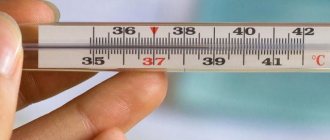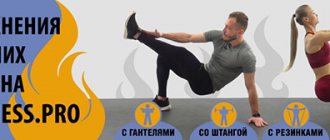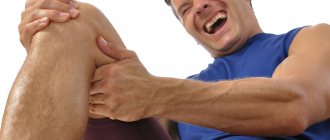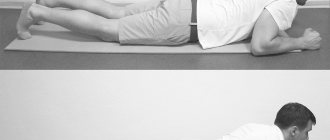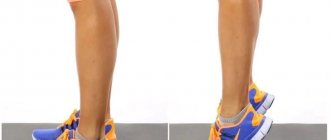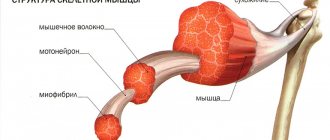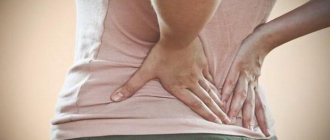Seizures in a child
Leg cramps in young children most often occur at night, after a busy day. The cause may be excessive stress on bones and muscles or sleeping in an uncomfortable position.
Regularly occurring cramps (during the day and night) indicate a lack of magnesium. Flat feet can also provoke involuntary muscle contractions.
The child should be reassured, find out what hurts, warm the calf muscles, and wrap them tightly with an elastic bandage. If it is not available, use ordinary children's tights. The bandage should be tight enough, but not impede the normal blood supply to the legs.
A separate category of seizures is febrile, which occurs at high temperatures. It is not the heat itself that causes them, but a sharp rise in temperature. The condition is dangerous, the child must be given first aid:
- Place the baby on its side
- Unclench your teeth and let them bite on a hard object so as not to hurt your tongue.
You can wipe the baby with warm water, hold his arms and legs so that he does not get hurt.
Constant cramps in the arms and legs - a dangerous symptom or harmless overexertion
Night or daytime cramps in the arms and legs are something that almost everyone has encountered. The attack makes it impossible to move normally for a few seconds, and then the affected limb may hurt for several days.
The cause of muscle spasm can be anything: from physical overexertion to the presence of a malignant tumor. If involuntary muscle contractions occur frequently, you should consult a doctor. Single spasms can be relieved on your own at home; recurring ones require examination and appropriate treatment.
Causes of leg cramps in pregnant women
Leg cramps in pregnant women are common, but they are usually not associated with renal failure or chronic diseases of the cardiovascular system. The reasons for the appearance of the syndrome in question during pregnancy in women can be:
- An imbalance of vitamins and microelements in the body, which may be associated with poor nutrition, thyroid dysfunction, diuretics, or excessively rapid/active growth of the fetus.
- Iron deficiency anemia, occurring in moderate to severe degrees. This condition is also associated with insufficient iron intake or blood loss in the first trimester of pregnancy.
- Hypoglycemia.
- Dehydration of muscles.
- Lack of oxygen in body tissues.
- Compression of the inferior vena cava by the enlarged uterus when the woman is in a supine position. As a result, blood circulation in the lower extremities is disrupted, and the result will be cramps in the legs.
- Chronic venous insufficiency. This is facilitated by the woman’s large weight, the increased volume of blood that circulates through the veins, and low tone and elasticity of the vessel walls.
Please note: pregnant women may develop eclampsia - increased blood pressure, severe swelling, and protein is found in the urine. The most dangerous thing with eclampsia is the occurrence of generalized convulsive seizures, which is an unambiguous indicator for urgent delivery
Insufficient blood circulation in the muscles
- For some people, the arteries that supply blood to the lower extremities become severely narrowed during exercise, leading to cramping during exercise.
- A sedentary lifestyle or, conversely, staying on your feet for a long time.
- Static muscle work during training (holding arms or legs in one position) can lead to short-term poor circulation and the appearance of muscle cramps.
- Also, the causes of circulatory disorders can be the same movements repeated over a long period of time, for example, typing on a keyboard or manually packing some goods in an enterprise.
Why do seizures occur?
There is a fairly wide list of etiological factors, under the influence of which convulsive muscle contractions can develop. One of the most common causes is micronutrient imbalance. Thus, with insufficient amounts of magnesium, potassium or calcium, as well as with other changes in the electrolyte composition of the blood, the regulation of muscle activity and the transmission of nerve impulses are disrupted, which in turn provokes convulsive contractions of individual muscle fibers. Micronutrient deficiency usually occurs in the following cases:
- taking certain medications, especially sorbents, antacids and diuretics;
- excessive secretion of cortisol, which is observed during stress and leads to deterioration of calcium absorption in the gastrointestinal tract;
- a lack of microelements is observed during pregnancy, since during this period the female body requires more of them;
- abuse of protein foods, which provokes calcium deficiency;
- excessive physical activity, during which increased sweating is observed, as the body loses potassium;
- lack of vitamin D, which in turn provokes insufficient absorption of calcium.
Other causes of leg cramps include the following:
- varicose veins of the legs;
- chronic circulatory disorders;
- pathologies of the thyroid gland;
- diabetes;
- flat feet;
- cramps in the legs also with polyneuritis (as a rule, such cramps occur at night; nerve damage is provoked by viruses, metabolic disorders, intoxication, hypovitaminosis);
- hypothermia;
- radiculitis;
- injuries and muscle strain, prolonged standing;
- chronic renal failure;
- period of active growth in children;
- degenerative-dystrophic lesions of the spine;
- wearing high-heeled shoes;
- poor nutrition;
- improper treatment of colds, which subsequently leads to disruption of the kidneys or heart.
If you are frequently bothered by cramps of the lower extremities, you should consult a doctor to determine the etiology of this disorder. Leg muscles can spasm due to certain infectious diseases, intoxication and various poisonings, neuroses, and traumatic brain injuries. Metabolic disorders, especially ATP, are of etiological significance. With insufficient synthesis of this compound, metabolism in muscle fibers is disrupted, which reduces their ability to contract.
In addition, convulsions can occur against the background of severe stress, when, under the influence of a high concentration of adrenaline, breathing accelerates and the level of carbon dioxide decreases, and this provokes a convulsive contraction of muscle fibers. During the hot period, the cause of cramps is dehydration. The lower limbs cramp due to vascular pathologies that develop against the background of physical inactivity, hereditary weakness of the vascular walls, as well as hormonal changes (for example, due to taking oral contraceptives). Another cause of leg cramps is chronic lack of sleep.
It is important to note that choreoathetoid muscle contractions that resemble cramps may be observed. They are mainly a consequence of pathologies of the central nervous system and are observed in the patient constantly, intensifying with changes in the emotional or physical state
They combine the appearance of grimaces on the face and worm-like movements of the arm, and sometimes the leg. In addition, there may be fasciculations. They resemble cramps, but do not cause pain or specific discomfort, occur rarely and represent rhythmic and rapid contractions of individual superficial muscle fibers. This is usually caused by overexcitation of motor neurons.
How to prevent it?
What can be done to prevent the nervous system from interfering with sports? Create a regimen for your exercises, taking into account age, muscle fitness, lifestyle, regularity and duration of exercise, types of exercises, the presence of bad habits and the state of health of the body at a particular moment.
With a fixed load on one muscle, metabolic processes of the breakdown of purine bases begin to occur in it with the formation of uric acid. Proper stretching prevents such a component from accumulating in one place and distributes it evenly over the entire area of the muscle. This also explains the beneficial effects of massages and rubbing.
When doing physical exercise, you cannot limit your body’s supply of nutrients, water, vitamins and minerals. The diet must be balanced and contain all the necessary elements.
Many people resort to sports exercises in order to lose weight. They are malnourished and exhaust the body with nutritional deficiencies. No matter how much a person wants to lose weight, intense physical exercise will not help achieve results. On the contrary, by depleting one’s biological resources, a person becomes weaker and often experiences causeless convulsive muscle contractions.
Pinched nerve
This is how many explain sudden pain, and there is a logic to it - a whole network of nerves extends from the brain along the spine. According to our expert, almost anything can cause them to become pinched, from a herniated disc to arthritis to those same awkward postures. Therefore, do not force your body with complex asanas for which it is not yet ready! “Fortunately, nature has endowed our body with the ability to recover from a variety of injuries,” the doctor consoles. – You can take anti-inflammatory drugs to relieve pain. But if it doesn’t get better after a couple of days, make an appointment with your doctor.”
BY THE WAY: If your legs cramp...
Recommendations for physical activity
It is, of course, unbearable to remain idle when your favorite painting on the wall is askew, but the result of careful alignment of a heavy frame can be not only the ideal position of the masterpiece, but also unpleasant cramps in the arm or back. Just imagine, being stuck in an uncomfortable position for a long time often ends in a spasm.
“Load for which the body is not prepared leads to microdamage to muscle fibers,” teaches Dr. Danesh. “The process produces lactic acid, which causes the muscles to contract painfully.” But it’s easy to get rid of this type of cramps, and even with health benefits - regular exercise will help. But if the spasms do not go away for several hours and even interfere with sleep at night, it is better to see a doctor.
- If you need to lift a heavy weight, it is better to divide it into parts.
- You need to carry the load with a straight back.
- After 30 minutes of work, take a break.
- The lunch break should not be less than 1 hour.
- A warm shower is recommended before going to bed.
- Sleep should be at least 6 hours a day.
- You need to fall asleep and wake up at the same time.
Compliance with the work and rest regime, proper nutrition and muscle load will prevent, and this is better than treating cramps.
Types of seizures
Cramps can be classified according to intensity and duration.
A severe epileptic seizure is called tonic-clonic. In this state there is no consciousness.
Partial states can be simple and associated with a complex of symptoms accompanied by loss of consciousness.
When the fibers or the entire muscle contract, we are talking about a myoclonic spasm. Such nighttime conditions are present in patients with impaired function or integrity of brain structures, sometimes with a lack of microelements. May be caused by other reasons.
Muscle cramps due to mineral deficiency in the body
Deficiency of minerals in the body. In this case we are talking about potassium, calcium, sodium and magnesium, which act as electrolytes, that is, they contribute to better conduction of nerve impulses. During intense training, a significant amount of these substances is excreted from the body through sweat.
In this case, the muscles stop receiving the necessary commands in a timely manner, and their work may malfunction. Moreover, the appearance of cramps may not necessarily occur during training. Most often, muscle cramps occur after the end of the workout. To do this, just stretch hard in your sleep.
To restore electrolyte levels, athletes try to include foods containing these elements in their diet. Such food sources include nuts, dried fruits, dark chocolate, sunflower seeds, milk, cottage cheese, cheese, buckwheat, beans, garlic, red beets. However, it is easier and more reliable to obtain them in sufficient quantities from vitamin-mineral complexes.
The Leveton Forte food supplement, created on the basis of natural plant components and beekeeping products, will help fill the deficiency of vitamins, minerals and amino acids that every athlete needs. This is an effective remedy for restoring natural testosterone levels, increasing physical endurance, adapting the body to heavy loads and increasing muscle mass.
In pregnant women
Women expecting a baby often experience muscle cramps that last for several days. The reasons for this may be different. Most often this occurs as a result of toxicosis, which may be the main cause. The most common factor is a change in mineral metabolism. This problem occurs at the cellular level, and this is facilitated by the potential difference on the cell membrane.
Problems with mineral metabolism arise due to the increased requirement of the expectant mother’s body for them. Huge reserves are spent on the vital functions and development of the embryo. Due to an eating disorder, a woman does not receive the necessary microelements. Deficiencies are almost always experienced in potassium, magnesium and calcium. Girls who are struggling with the problem of edema can take special medications that promote copious urine output. Low blood hemoglobin contributes to oxygen starvation of the muscles and leads to tics.
As a result of compression of the inferior vein by the fetus. This contributes to the disruption of blood flow and a picture similar to varicose veins is observed. In this case, it is especially painful at night, as the abductor muscles experience oxygen starvation at this time. If you have discomfort at night, then you need to consult your doctor, only he can help eliminate this problem and tell you what to do in a particular case.
Causes of convulsive muscle contractions in children
In children, convulsive syndrome occurs much more often than in adults; this occurs due to the immaturity of various brain structures and an incompletely formed thermoregulation center. One of the most common causes of seizures in children is hyperthermia.
In addition, muscle cramps in children can develop as a result of a number of reasons, among which it is worth highlighting:
- diseases of viral or bacterial origin;
- traumatic damage to the meninges;
- intracerebral hemorrhage;
- poisoning of the body with toxic substances or decay products of pathogenic microorganisms;
- metabolic disorders that increase the likelihood of developing pathologies of the nervous system;
- hereditary predisposition;
- bleeding disorders;
- epileptic syndrome.
Only a qualified specialist can say exactly why a child has muscle cramps and what to do in such a situation, after conducting all the necessary tests.
Convulsive contraction can affect any muscles: respiratory, facial and laryngeal, and spasms of the masticatory muscles can also be observed. But no matter what kind of convulsions you have encountered, you should not neglect medical advice, since such a condition may indicate the presence of quite serious diseases.
Not only professional runners suffer from sharp, excruciating pain; anyone is at risk: active and sedentary, young and not so young. Moreover, a muscle can contract at the most inopportune moment - say, during yoga or when you go to bed.
“A spasm is an overactivation (contraction) of a muscle,” explains Dr. Human Danesh, director of pain medicine at Mount Sinai Medical Center in New York. “They can occur anywhere, but most often the calf cramps because they bear the heaviest loads during the day .” What brings the muscles to this state? There are five main reasons.
Diagnosing the causes
Cramps and the reasons for their occurrence are a topic for discussion with your doctor. After all, this problem can be diagnosed during the collection of anamnesis. The doctor learns in conversation with the patient about his habits, daily routine and diet. All this information, provided to the doctor in a confidential conversation, can tell you why your legs, arms or other muscles are cramping.
In addition, a doctor can detect anemia and low levels of potassium and magnesium in the blood by chronic fatigue, drowsiness and muscle weakness. A blood test can confirm this.
Psychoneurological abnormalities are diagnosed by sleep disturbance, the patient’s general nervousness, irritability, and the presence of nightmares. In this case, daytime cramps and night spasms, or rather their intensity and frequency, can help clarify the diagnosis.
An imbalance of hormones and microelements can also be indicated by the patient’s appearance, such as brittle hair, flaking nails, pale skin, cold extremities, sore teeth, as well as tachycardia and arrhythmia. Against the background of such manifestations, the patient may be prescribed additional consultation with specialized specialists; gastroenterologist, immunologist, cardiologist, and so on. Only a comprehensive and complete study will answer why the muscles cramp.
Causes of seizures
An increase in the number of nerve impulses sent by the central nervous system. This can occur with the following diseases:
- Epilepsy is a disease in which a focus of excessive activity forms in the brain.
- Acute psychosis is a mental illness in which increased brain activity is recorded.
- Eclampsia is a pathological condition of pregnant women that occurs with cramps not only of the limbs, but also of the abdominal muscles and uterus. This condition threatens the life of the pregnant woman and the fetus, as it leads to placental abruption.
- Traumatic brain injury. Only significant trauma complicated by a subdural hematoma can lead to seizures.
- Intracranial hemorrhage, when blood spreads into the brain tissue and disrupts its functions.
- Ischemic stroke is a disease in which one of the brain vessels spasms or is blocked by a blood clot. In this case, the area of the brain supplied with blood from this vessel begins to experience oxygen starvation and work in an abnormal mode.
The next factor in the occurrence of seizures is an excess of acetylcholine in synapses. This may happen under the following conditions:
- Overdose of cholinesterase blockers (Proserin, Galantomin, Physostigmine). This is a group of drugs that is aimed at blocking the destruction of acetylcholine. Used for atony (inability to contract) of the smooth muscles of internal organs.
- Deficiency of magnesium ions in the body. This microelement is involved in the opening of channels through which excess acetylcholine leaves the synapse. With a lack of magnesium, these channels remain closed and acetylcholine accumulates.
The sensitivity of a muscle cell to a nerve impulse is not a constant value and depends on several factors. For example, if the concentration of electrolytes in the blood is disturbed, the sensitivity of the cells increases, and contraction occurs even when exposed to weak impulses. This condition can occur due to dehydration (vomiting, diarrhea) or intoxication (poisoning with toxins). Hypovitaminosis of vitamins D, E, group B also increases the sensitivity of cells to impulses, and fibers contract more often. A decrease in the amount of energy required to contract muscle fibers occurs in the following cases:
- Diabetes mellitus is a disease, one of the complications of which is angiopathy (impaired blood supply). As a result, the muscles also lack blood and the oxygen supplied with it. And without oxygen, ATP cannot be formed.
- Inferior vena cava syndrome is a condition unique to pregnant women. The enlarged uterus begins to compress the inferior vena cava when the woman lies on her back. In this case, the blood supply to the lower extremities sharply deteriorates, muscles and tissues are in oxygen starvation and in a state of edema. All this leads to a lack of energy in the cells.
- Heart failure. One of the manifestations is swelling of the lower extremities. And the consequence of this is a lack of oxygen and nutrients in the tissues, including the muscles of the lower extremities. Which is why there is not enough ATP to carry out full contraction and relaxation.
- Thrombophlebitis is an inflammatory disease of the veins of the lower extremities. The result of this disease is stagnation of venous blood in the legs and their swelling. Metabolism in the tissues of the lower extremities becomes difficult, the cells experience energy starvation. The functioning of the muscular system is disrupted, and convulsions occur.
- Anemia is a decrease in the number of red blood cells and/or hemoglobin in the blood. There are many reasons for the development of anemia, but the result is the same – oxygen starvation of the whole body.
From all of the above, it follows that there are many reasons for the development of muscle cramps. Only a doctor can deal with everything to find out the exact cause. It is better if the examination is started immediately after the first occurrence of a seizure.
At-risk groups
Athletes and all people who are physically active are most often susceptible to muscle strain. Spasms can begin not only during the actual training, but also much later. Sometimes cramps occur 4-6 hours after the actual exercise.
Elderly people are also at risk. The main reason for this is the age-related decrease in muscle mass that occurs after 40 years, as well as a sharp decrease in physical activity.
Young children have poor muscle tissue control, so seizures can occur at any time. In pregnant women, in 30% of cases, muscle tissue also cramps. This condition occurs due to a sharp fluctuation in weight in the direction of increasing mass.
Post-workout cramps cannot be controlled. However, it is necessary to try to understand what provokes their appearance. The first priority should be given to disproportionate physical activity. As a result, a signal of overvoltage is sent to the brain, and it gives a command to functional blocking.
The second factor is water-salt imbalance. During exercise, the body intensively evaporates moisture, which reduces its physical endurance. In addition, electrolytes (substances that can conduct electric current) leave the body along with sweat. The most important of them include chlorine, magnesium, calcium, sodium, and potassium. Thanks to such components, electrical impulses are formed in the body, stimulating the work of the heart muscle, respiratory and nervous systems.
This factor is directly related to impaired blood supply to the muscles, insufficient saturation of them with oxygen and essential nutrients. If tissues experience a lack of blood supply, they experience impaired metabolism and, consequently, the ability to convulse.
The following risks cannot be completely excluded: hypothermia, previous long-term use of medications, the presence of chronic diseases, experiencing stressful situations, severe allergic reactions, smoking and alcohol.
Cramps of the calf muscle. Why does my calves cramp?
Why do my calves cramp?
A cramp in the calf muscle of the leg is a fairly common phenomenon that almost every person experiences sooner or later. Characteristic and very unpleasant sensations usually occur unexpectedly and can cause serious trouble. Therefore, it is very useful for everyone to know more about calf muscle cramps and simple methods to combat them.
There are quite a few reasons for sudden spasmodic muscle contractions that are not related to diseases. If you lead a sedentary lifestyle - a taxi, a chair in the office, a chair at home, then the cause of cramps may be insufficient stimulation of the leg muscles by the nervous system. However, excessive physical activity, such as sports or long walking, can also become a problem, when lactic acid accumulates in the muscles. Lack of sleep, chronic fatigue, poor circulation due to an uncomfortable posture can also become causes of muscle spasms. However, experts call the most common causes of calf muscle cramps a chronic lack of elements in the body such as vitamin D, magnesium and calcium.
You should be aware that seizures can be symptoms of a wide range of diseases, such as diabetes. varicose veins, spinal diseases, liver cirrhosis (www.diagnos-online.ru/zabol/zabol-185.html), complications during pregnancy and many others. Therefore, if convulsive symptoms appear regularly, you should consult a doctor.
Diagnosis by symptoms Select the symptoms that bother you and get a list of possible diseases
Preventing calf cramps
As a preventive measure, we can recommend a nutritious diet and regular exercise. The average person does not get the required daily dose of magnesium and calcium from food. Therefore, for prevention, it is recommended to take dietary supplements or medications containing magnesium and calcium. As a rule, they are included in preparations along with vitamin D, which promotes their normal absorption. Of course, it is always good to eat fresh vegetables and fruits. And also: milk, cottage cheese, cheese, dried apricots, which contain a lot of calcium; walnuts, legumes and buckwheat porridge, which are a source of magnesium in food.
Relieving calf muscle cramps is usually easy. The easiest way is exercise. You need to stand facing the wall at a distance of a step, rest your palms on it and slowly retreat from the wall in small steps. The feet should not be lifted off the floor to allow the calf muscles to stretch. You should stand for a minute, allowing your muscles to stretch. However, you shouldn’t let it get painful.
Massage is also a fairly simple method, however, it is not recommended for pregnant women. Use your thumb to press on the middle of the calf muscle, gradually increasing the pressure. Then you need to press a point in the popliteal fossa for a couple of seconds. The following method is known as an emergency way to relieve cramps: you need to prick with a pin or needle into the area where the spasm occurred. The resulting painful irritation should relieve the muscle spasm.
Prevention
To prevent seizures, you should pay attention to your lifestyle and minimize provoking factors:
- adjust your diet based on healthy eating habits,
- wear comfortable shoes with orthopedic arch support,
- dress according to the weather, do not expose your feet to hypothermia,
- monitor moderation of physical activity, do not overtrain the lower leg,
- carry out contrast douches in the shower every day,
- do joint exercises and stretching,
- determine for yourself the optimal position during sleep, in which the blood vessels of the legs will not be compressed,
- Perform a warm massage on the problem area several times a week.
Is there a difference between muscle spasms and cramps?
Common people are more likely to call convulsions an involuntary contraction of skeletal muscles. In the same category, people include attacks of stiffness and pain that occur, for example, in the calf muscle during sleep, in cold water or after intense muscular work. To explain their condition, patients use generally accepted, and therefore understandable in all circles, terminology: “cramped arm, a cramp began in the leg, severe cramps in the fingers began...” Everything is correct, but contractions of the smooth muscles of the vascular walls, intestines, bronchi and other organs that occur without a human command are also convulsions, which are usually called spasms.
Also closely related are headaches and cramps of this (spasms) and other (striated muscle tension) types. Attacks of cephalalgia are caused by:
tension headache due to spasm of the head muscles
Spasms of cerebral vessels, which are nothing more than a contraction of smooth muscle fibers of the vascular wall;
Spasm of the esophagus, causing tension and sharp pain in the chest, neck, ears and throughout the head, although the extremely unpleasant sensations do not last long; Tension of the neck muscles when turning the head in patients suffering from osteochondrosis of this part of the spine.
In addition, various other factors (cold, stress, diseases of the brain and internal organs) can cause headaches and cramps at the same time, so a person often does not have time to understand: the cramps caused illness or the headache first, and then other symptoms appeared.
Thus:
Cramps can affect smooth muscles, cause pain and functional disturbances in the functioning of internal organs: bronchospasm underlies a disease such as bronchial asthma, spasm of the coronary vessels causes attacks of angina, intestinal colic occurs from sudden tension of the intestinal walls, and headache is a consequence of spasm of cerebral vessels ; Cramps occur due to a sudden contraction of skeletal muscles (cramps of an arm, leg, fingers, etc.). The body's motor ability most often suffers from such muscle contractions.
seizures: tonic (top) and clonic (bottom)
Taking into account the nature of the convulsive attack and the duration of muscle contraction over time, convulsions are divided into:
Tonic – muscles remain tense for a long time; Clonic - phases of tension and relaxation replace each other, causing the muscle to perform characteristic twitching (jolts); Tonic-clonic.
Jerky contractions that involve all the muscles of the body (at the same time contracting the legs, arms, and fingers) are often called convulsions by people.
How to quickly provide first aid
If your calf suddenly cramps and you feel severe pain, you need to use one of several methods to relieve muscle tension:
- Deep massage . The muscle in which pain is felt must be vigorously massaged. This will help relieve the spasm.
- Elastic tape . Special bandages and tapes can be found in sports stores and pharmacies. If you wrap them around the place where the pain is felt, the muscle tension will subside.
- Stretching . You need to sit down and, stretching your legs in front of you, bend them slightly at the knees. Then you need to grab your toes and pull them towards you. At this moment, tension and stretching should be felt at the same time. If you can’t do this exercise yourself, you can ask for help from those around you.
- Injection into the muscle . You can prick with a needle or pin. But it is important to do this carefully. It is advisable that this procedure be performed by a specialist who understands exactly where and how to inject. Otherwise, there is a risk of infectious disease pathogens entering the blood. Improper use of a needle can damage the nerves and blood vessels under the skin.
- Quick change of body position . If a calf muscle cramp appears at night, you need to immediately get out of bed and start walking. A cold floor surface will enhance the spasm-relieving effect.
- Applying mustard plaster . This action will help warm up the muscles and relieve tension. To achieve a greater effect, you can put your foot under hot water.
If you have a cramp at night, you need to sit down, bend your knees and pull your toes towards you.
Complementary therapy
Physical therapy that affects the limbs has a good effect. To reduce the manifestation of convulsive symptoms to nothing, it is recommended to regularly perform the following exercises:
Take the starting position standing. Stand on your toes and stretch your arms up. It is advisable to stay in this position for a few seconds and repeat the exercise 5 times. Get on all fours. Stretch your right hand forward and your left leg back. Hold for 5 seconds and switch limbs. Repeat 10 times in total. Lie on your stomach. Stretch your arms and legs and relax as much as possible. Then gently stretch in opposite directions. You should alternate between relaxation and tension. Only 5 approaches. While lying on your back, lift your leg and massage the calf with light claps over the entire surface of the skin. Perform the action for 1 minute. Then repeat with the other limb. Sitting on a chair, alternately bend and straighten your fingers and toes. Movements should be gentle. If pain occurs, the action must be stopped immediately. If the cause of the symptom is varicose veins, then it is very good to take an upside-down position: so that the lower limbs are located higher than the body. The best way is to lie on your back. Place your feet on the wall. Ideally, they should be located at right angles. If this is not possible, the exercise should be performed in any convenient position of the limbs. The main thing is that they are not bent at the knees. Sit up straight and stretch your legs forward. Slowly bend towards straight limbs as far as the stretch allows. The emphasis should be placed not on bending over, but on reaching with your hands towards your straight legs. You should stay in this position for 10 seconds, rest, then repeat 5 more times. Sitting on the mat, alternately rotate your hands and feet, trying to make smooth circular movements. Repeat 30 times.
After a set of exercises, it is recommended to finish the therapeutic training with patting movements. In this way, blood will begin to circulate better, feeding sore muscles with useful substances and saturating them with oxygen. If you alternate exercises and relaxing baths, recovery will come very soon. Before going to bed, a light massage will have a good effect.
Many people underestimate the occurrence of cramps in the fingers and toes, and in vain. After all, this may be a sign of serious disorders in the brain, then the above methods will be useless. That is why you cannot self-medicate; you must seek advice from a specialist who will conduct a high-quality diagnosis and prescribe competent treatment.
Basically, they come at night, in a dream, although they always wake a person up and make him writhe in pain. “Writhing” is what old people would call a phenomenon when legs, arms or other parts of the body cramp. Nowadays such a word is no longer in use, and contractions of muscle fibers that do not depend on the will of a person have their own names (convulsions, spasms) or are simply expressed: a leg (arm) cramped.
Cramps often appear as symptoms of a certain pathology, that is, they always have a reason and, depending on it, cramps can be rare, frequent, constant, affect one muscle or a whole group, occur in skeletal muscles or prefer smooth muscles...
Special exercises for the treatment of leg cramps
Rehabilitators have developed a set of exercises for the treatment of leg cramps, special movements performed at different times of the day.
For morning exercises you should do the following exercises:
- cross your feet and focus on the outer edges. After 15 seconds, return to the starting position;
- While sitting, tense your toes and sharply relax. Repeat the action several times;
- rise on your toes and stand in this position for up to 5 seconds. Return to the starting position, repeat several times.
For the evening, doctors recommend gymnastic complexes:
- make circular movements with your legs while sitting on a chair;
- alternately bend and straighten your toes;
- walk on your toes;
- Sitting on a chair, straighten your legs and tense your muscles, then relax. Perform the exercise alternately up to 10 times.
Exercises are done barefoot. They relieve tension, restore blood circulation, and relieve swelling of the legs after daytime stress.
The exact treatment program can be chosen only after determining the disease that underlies the sudden muscle contractions. In the case of regularly recurring seizures of a local or general nature, at first it is necessary to use pharmaceutical solutions that can eliminate the symptoms and improve the general condition:
- With a high potassium content (Panangin and Asparkam). Restore normal functioning of muscle tissue and block the development of spasms.
- With a high content of magnesium (Magnelis and Magvit). They help to establish water-electrolyte metabolism and eliminate the deficiency of microelements in the body.
- Creams and ointments, the effect of which can reduce pain and relieve tension in certain areas of the body (Venoflebin and Troxevasin).
To get rid of cramps once and for all, it is not enough to simply massage and pull the sore muscle. It is necessary to influence precisely the causes of this pathology. For this, by the way, a whole list of treatment and preventive measures is used.
First of all, you need to take care of a sufficient supply of calcium, potassium and magnesium in your body. To do this, you need to improve your nutrition and include the vitamin and mineral complex Apitonus P in your diet. This drug contains bee pollen containing potassium, magnesium and calcium - the main microelements necessary for proper muscle function.
The abundance of these beneficial substances in the body helps prevent the occurrence of seizures. In addition, Apitonus P also contains dihydroquercetin, royal jelly, as well as vitamins C and E. Acting together, the components of the supplement provide a synergistic effect and have a beneficial effect on the body. Among the beneficial properties of Apitonus P are: strengthening the immune system, strengthening blood vessels, protecting against aging, etc.
For those who for some reason lack calcium, it is recommended to take the drug Osteomed. It contains calcium citrate, the most digestible salt of this mineral. Due to the rapid absorption of this macronutrient, the Osteomed supplement is more effective than similar drugs. By taking Osteomed, you can forget about calcium deficiency and prevent leg cramps.
To treat varicose veins, which is also the cause of leg cramps, you need to take Dandelion P. The active component of this supplement improves venous blood flow, which normalizes mineral metabolism and eliminates the occurrence of cramps.
The dietary supplement Valerian P. will help get rid of leg problems associated with stress. Valerian in its composition calms the nervous system and reduces the likelihood of seizures.
What to do if your muscles are cramped
Typically, seizures are a short-term phenomenon, and therefore most often go away on their own, even without going to the hospital. But since they cause obvious discomfort and even pain, use the following recommendations to eliminate the problem as quickly as possible:
- Stop doing the activity that caused the cramp.
- Very slowly, try to stretch the muscle that is cramped and begin to massage it. If the cramp covers the calf muscle, extend the toe of the foot and pull it outward, toward you.
- Do not try to perform any movements immediately, even if the cramp stops. If you try to quickly stand up, the pain may return.
- If the muscle continues to hurt even after the spasm has passed, apply ice to it. If necessary, you can even use an elastic bandage.
- If you notice that the cramped area of the body remains hard and tense, continue to massage it and warm it up with compresses.
In what cases should you consult a doctor?
If your legs cramp very often and/or the spasms do not stop for a long time, you should think about visiting a doctor. You should be especially wary of the situation when cramps occur without any physical activity.
Ignoring this symptom can lead to complications, and in some cases, even death - so try to schedule a visit to a therapist or neurologist as soon as possible.
Attention! Do not self-prescribe medications to treat muscle spasms (even vitamins). If you incorrectly determine their cause, self-medication can only make the situation worse.
Such a simple treatment
The duration and frequency of seizures depends on the disease or abnormality in the body. Most often, to completely get rid of seizures, no special treatment is required; it is enough to adjust your habits, balance your diet, or take a course of special vitamin complexes. But they should be prescribed by a doctor who knows exactly what microelement the body needs.
The most common prescriptions for seizures:
- taking medications with magnesium - Magne B6, Magnevit, Magnesium Sulfate, etc. – to restore normal electrolyte metabolism in the body. Also foods and vegetables that contain it: cocoa, broccoli, bananas, avocados, etc.;
- a course of drugs with a high potassium content - asparkam, panangin, which also contribute to the proper contraction of muscle tissue. The diet should include baked potatoes, greens, dried fruits, dried apricots, beans, prunes, raisins, figs, etc.;
- calcium preparations – calcium D-3 nikomed, calcemin, as well as cottage cheese, fermented milk products, nuts, grains, beans, seeds, bird eggs, soybeans, fish;
- in case of stagnation in the vessels and impaired blood flow, the phlebologist can prescribe a course of venotonics.
The diet should be balanced, and it is necessary to monitor the amount of fluid consumed during the day. For an adult this is 1.5-2 liters.
Taking vitamin complexes will become meaningless if you do not give up habits that contribute to their rapid elimination from the body, and neglect of the condition of blood vessels will lead to thrombophlebitis or varicose veins. To do this you need:
- limit the consumption of strong black tea and coffee, which contribute to the leaching of calcium from the body, and also avoid drinking alcoholic beverages;
- avoid overload on the legs associated with long standing;
- do not sit with your legs crossed, thereby disrupting blood flow;
- control physical activity and wear comfortable, spacious shoes (heels no higher than 5 cm);
- give your feet frequent rest by elevating them or placing them on a bolster and placing a cold water compress on top.
How to protect yourself from cramps before competitions
– Tell me, is it possible to somehow protect yourself from cramps, for example, before a competition?
- Certainly. First, monitor the indicators of a biochemical blood test. Secondly, eat well.
– What is taping?
– Taping is a technique of applying a special adhesive tape to injured areas. Typically, tape is attached over damaged muscles and joints, partially relieving them of the load and providing rest, but today this method is also used for preventive purposes, for partial immobilization of joints that bear increased load. The tape will definitely protect the muscle from cramps before the competition.
23.08.2018
Interviewed by Rimma Petrak
Causes of seizures
Despite the fact that modern medicine has quite strictly defined risk groups for the occurrence of seizures, there are no scientifically substantiated reasons for the occurrence of muscle spasms. However, there are several hypotheses that more or less plausibly explain this phenomenon. One of them says that abnormalities in the mechanism of muscle contraction are caused by poor stretching of the muscle. Another theory is that the cause is an imbalance of electrolytes in muscle tissue, namely calcium, magnesium, potassium and sodium.
The theory of impaired neuromuscular communication is considered by most scientists who study the muscles of athletes. They explain seizures with disruption of the connection between the cerebral cortex and the spinal cord. In general, scientists studying all theories of the occurrence of convulsive spasms have developed a list of reasons that satisfy all areas of medicine:
- Diseases of the endocrine system - the thyroid gland, adrenal glands, pituitary gland and hypothalamus. All this leads to an imbalance of hormonal levels in the blood.
- Low sugar content. Usually this phenomenon occurs due to non-compliance with the insulin regimen and poor diet in a person with diabetes.
- Strong long-term stress on the leg muscles associated with some sports; football, athletics, swimming and the like.
- The calf muscles most often cramp due to thrombophlebitis or varicose veins.
- Atherosclerosis, expressed by poor circulation in the legs.
- Circulatory disorders caused by cardiovascular diseases. In this case, seizures most often occur on the soles of the feet.
- Spinal diseases such as intervertebral hernia or osteochondrosis.
- Excessive amount of estrogen in a woman’s blood. Most often this situation occurs with pregnant women.
- Prolonged stress and sleep disturbance.
There are a number of other reasons for the appearance of muscle cramps, they are caused by the lifestyle and behavior of the person himself, this is wearing high-heeled shoes, untreated viral diseases, poor and irregular diet, alcohol abuse, smoking. All this can cause vasospasm and disrupt the balance of salts and minerals in the body. Which, accordingly, leads to night cramps or muscle spasms at the most unexpected moment.
When you can't ignore a cramp
A frequently recurring spasm can become a bright, screaming sign of varicose veins or thrombophlebitis. In this case, it is not necessary that the veins in the legs appeared and were visible to the naked eye; at this very last stage, the disease is very difficult to control and fight.
Repeated cramps can be a harbinger of varicose veins.
If, in addition to cramps, you begin to notice that your legs and ankles are swelling, your legs quickly get tired from even simple and short movements, and spider veins appear on your hips, then you should visit a doctor and consult about this disease.
However, very often a cramp can be a symptom of serious problems, including:
- Renal failure , since this disease disrupts the normal removal of metabolic products from the human body, their toxic effect can lead to seizures;
- Chronic disorders in the circulatory system in the part that supplies blood to the lower extremities. Do not forget about obliterating atherosclerosis and other similar diseases;
- Diseases of the cardiovascular system , which are accompanied by manifestations of heart failure;
- Imbalance of female sex hormones (namely, excess estrogen in the blood). This reason concerns exclusively the female half of humanity.
Why do muscles often cramp?
Muscle cramps or spasms often have no clear cause. However, if they keep you up at night or interrupt your workout, look into these common causes:
- Dehydration.
Dehydration is a classic cause of cramps. Hot weather and exercise further deplete your body of water as you sweat to keep yourself cool.
- Sit or stand.
Muscles were made to move, so remaining seated for long periods of time can lead to spasm.
People who have sedentary jobs often spend long periods of time with muscles locked in unnatural positions, says Dr. Dickens-Celestine. In this case, part of the treatment plan is to find ways to create breaks throughout the day. And optimize ergonomics to relieve stress. The role of magnesium in the body.
- Excessive use of muscles.
If you go on a long bike ride or do an intense workout, you may experience a cramp. When the nerves running from the brain and spinal cord down to the muscle become overstimulated, the muscle may respond with spasms. If you increase the intensity of your workout too quickly, your muscles are not used to the new movement and this can cause cramping.
- Mineral deficiency.
Electrolytes and other minerals are critical to keeping your body balanced and free of cramps and spasms. In some cases, a lack of magnesium, calcium, sodium or potassium may contribute to cramping. Including bananas, nuts, sweet potatoes, spinach and yogurt, which are rich in these minerals, in your diet can help.
Talk to your doctor if your muscle cramps last a long time or are extremely severe. How to treat foot pain.
Are there any medications
As you know, always try to treat the underlying cause first. Vitamin E supplements or vitamin B complex may be helpful. Magnesium supplements have also shown some benefit, mainly in pregnant women. Diphenhydramine and calcium channel blockers may be suggested by your doctor. Quinine has previously been used to treat nighttime leg cramps. However, due to its potential for serious and life-threatening side effects (cardiac arrhythmias, thrombocytopenia, and hypersensitivity reactions), it is no longer recommended as a treatment option. In this article, we looked at why muscles often cramp.
Muscle groups most susceptible to cramps
The following muscles are most susceptible to overstrain:
- Semimembranosus, biceps, semitendinosus. They form the back of the thigh.
- Calf. Located on the back of the lower leg.
- Four-headed. It is located on the front side of the thigh.
- Breasts. Located along the entire chest.
In addition, the muscles in the arms and even the feet often cramp.

